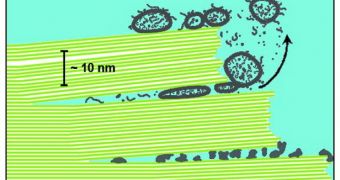The question of where and how life on Earth started has been with humans ever since the earliest days. Numerous shamans, witches, alchemists, priests and scientists attempted to uncover the answer, but their ideas and proposals oftentimes failed to produce any evidence of what they were arguing for. Over the past century, the prevailing theory has been that life emerged in a primordial soup, where precursors to amino-acids, proteins, RNA and other molecules existed. This proposal is now being questioned by a new theory, which is gaining an ever-increasing following.
The concept is authored by Helen Hansma, who is a professor at the University of California in Santa Barbara (UCSB). Back in 2007, while speaking in front of experts gathered at the annual meeting of the American Society for Cell Biology, she proposed the so-called “life between the sheets” mica hypothesis. Now, in a paper that will appear in the September 7, 2010 issue of the esteemed Journal of Theoretical Biology, she details the idea. Her proposal only changes the “settings” in which the earliest life forms developed, and not the mechanisms these cells used to do so.
Mica is a relatively common mineral that is capable of cleaving into smooth sheets. As mica organizes into layers, structured compartments form in between. Hansma says that these are the places where life on Earth originated, or the place where the earliest precursor molecules to today's genetic material were able to endure the harsh conditions of the primitive Earth. The compartments between the mica layers provided the prebiotic structures with the physical and chemical environment they needed to grow, and eventually become incredibly complex. According to Hansma, the earliest cells appeared between mica layers as well, experts at the US National Science Foundation (NSF) report.
“Mica sheets are atomically flat, so we can see DNA molecules on the mica surface without having to cover the DNA with something that makes it look bigger and easier to see. Sometimes we can even see DNA molecules swimming on the surface of mica, under water, in the AFM [atomic-force microscope]. Mica sheets are so thin (one nanometer) that there are a million of them in a millimeter-thick piece of mica,” the author of the mica hypothesis says. “It occurred to me that this might be a good place for the origins of life – sheltered within these stacks of sheets that can move up and down in response to flowing water, which could have provided the mechanical energy for making and breaking chemical bonds,” Hansma explains.

 14 DAY TRIAL //
14 DAY TRIAL //